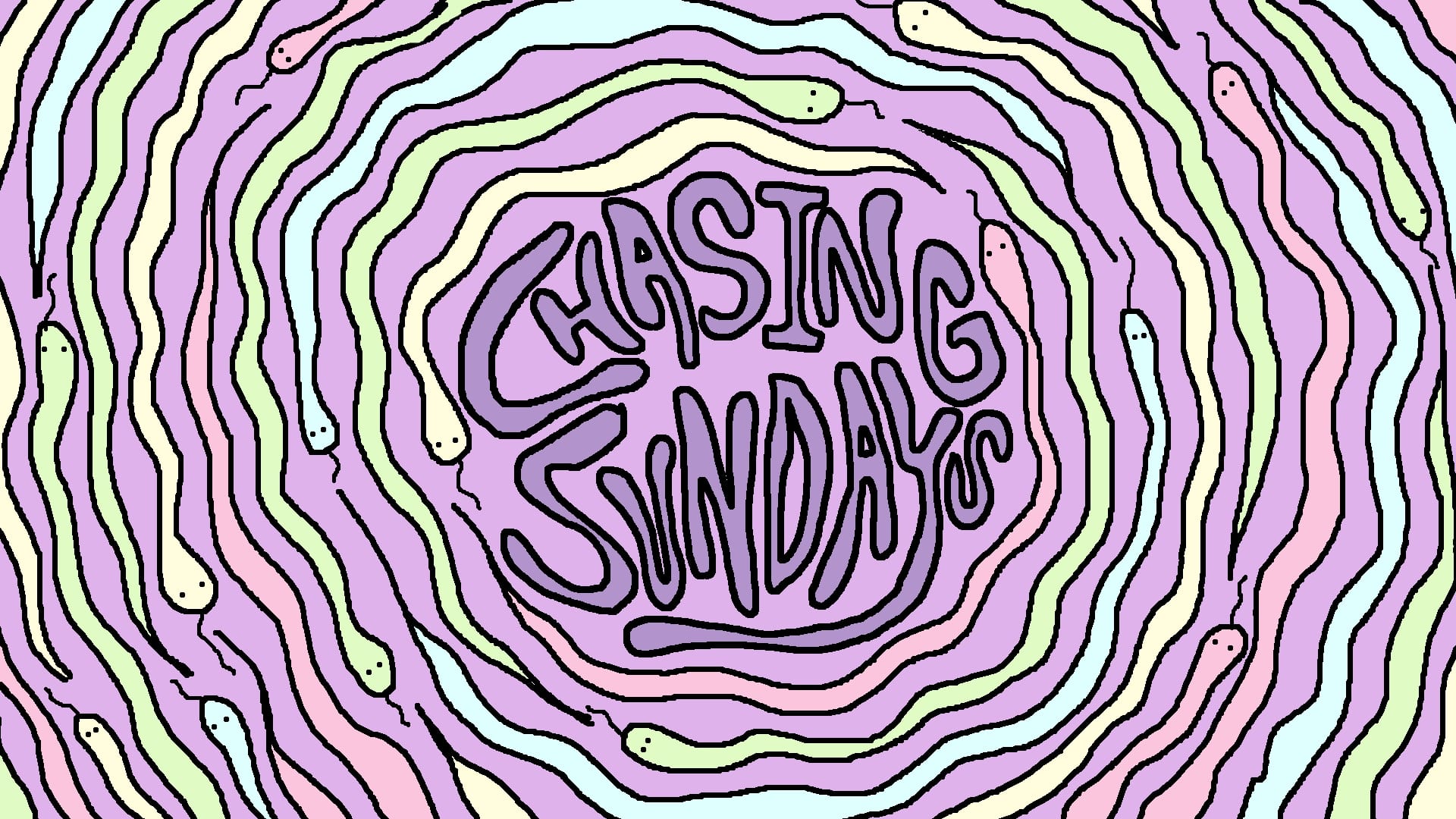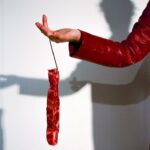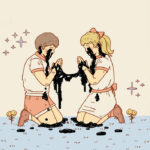Chasing Sundays Dec. 2020
Posted: by The Alt Editing Staff

Chasing Sundays is Eli Enis’ bi-monthly deep-dive into vast the world of shoegaze. From its celestial pop outer-edges to its overwhelmingly heavy inner-core, these are some of the most valuable inclusions to the global shoegaze canon.
It’s hard to determine what a “good year” for shoegaze is. I can’t think of any rock genres that are as consistently fertile as shoegaze has been for the last 20 years, but that feel completely isolated from the indie-rock zeitgeist (I’m using this term extremely broadly). It was a huge deal when Slowdive and My Bloody Valentine released their comeback records in the 2010s, bands like DIIV and Have A Nice Life that are pretty well-regarded in the critic sphere, and there are festivals like Desert Daze that make somewhat of an effort to include shoegaze bands in their lineups. But for the last five years in particular, shoegaze has kind of just trudged forward in the periphery of the press and the broader musical consciousness.
There are countless new bands, a healthy amount of innovation, and plenty of reliably classic-sounding records that drop each year that, for whatever reason, just don’t get the same attention that “x post-punk band that sounds exactly how post-punk bands in 1986 sounded” gets. Sure, there are genres like hardcore that are similarly siloed, but hardcore has never relied on critical consensus or nods from the mainstream to keep fuel in the tank. When shows are happening, there are dozens of well-attended hardcore festivals all over the world that create a tangible record for how healthy the scene is each year. Shoegaze is also self-sustaining in that the shoegaze community really fucks with shoegaze and is generally receptive to new bands, but it just feels a lot less visible than something like hardcore or post-punk, which have more physical and critical opportunities, respectively, to check their vitals.
Maybe that’s a good thing, though. Clearly, by virtue of this column existing, in which I find myself digging through an overwhelming trunk of new shoegaze albums every couple months that I have to whittle down to eight albums, the genre is doing fine without any meaningful affirmation from beyond its borders. So if no one else will say it then I will: 2020 was a great year for shoegaze. Beyond the big drops from Hum, Ringo Deathstarr, and Nothing (more on that later), there was a chunk of releases from some brand new bands that I’m extremely excited about, and there were some really great comebacks from veteran acts who are still finding ways to push the genre forward.
This edition isn’t a “best of the year” list or anything like that. But I will say that, without specifying, my favorite shoegaze releases of 2020 do appear in this haul. Enjoy.
Nothing—The Great Dismal
It’s always worth mentioning that this column is named after a Nothing song, and to get all of my biases out into the open, Nothing are probably my favorite shoegaze band. But if you think that makes me prone to fanboying, it’s actually quite the opposite. I hold any artist who makes my favorite music in a given genre to an extremely high standard, and after I was pretty lukewarm on Nothing’s 2018 album Dance on the Blacktop, I was as excited as I was worried about how I would feel about The Great Dismal. However, after giving it a few months to thoroughly soak in, I feel comfortable saying that this is the best Nothing album to date. We’ll see if it ends up being my favorite, but from an objective musical standpoint, this record contains the most well-crafted, lyrically profound, and pristinely produced tracks in their entire catalog.
First off, the sound of this album out of this world. I recently wrote a piece for a different site about how bands like Nothing are embracing modern production to push the genre forward, and Nothing frontman Domenic Palermo and their producer Will Yip talked to me about how they got this record to sound the way it does. They’ve always been a pretty dynamic band, but I’ve always been drawn to Nothing’s biggest, most crushing songs, and “April Ha Ha”, “Say Less”, and “Famine Asylum” are absolutely fucking titanic. “Say Less” is an industrial metal buzzsaw, “April Ha Ha” features a torrential downpour of molten guitars, and the string bend during the lead lick of “Famine Asylum” sounds like a tear in the universe.
Each of those make Nothing classics like “Vertigo Flowers” and “Eaten By Worms” sound like demos by comparison, and those three tracks alone satiated my hankering for the truly heavy moments that I thought Blacktop lacked. And in terms of melody, which I also felt was missing from Blacktop, “Catch A Fade” is the strongest hook Palermo’s written since “Chloroform”, and I think it could easily cross over into college radio and play well in a mix of Japanese Breakfast and Jay Som. Sadly, the record loses me during its final two tracks, which sound too much like Hum to hit me in a year with an actual Hum record. But the eight-song run that precedes it is damn near flawless, and all the risky moves in that passage pay off big time.
Opener “A Fabricated Life” is heartbreakingly beautiful both lyrically (“What else can I ask for? / I’ve pummeled through my time”) and musically (angelic reverb, harp contributions from Mary Lattimore, a moving vocal performance from Palermo), and “Bernie Sanders” has a very cool, almost Talking Heads-esque groove and a masterfully executed reverse reverb lead. “In Blueberry Memories” is just an impressive song all around: a sleek, sexy rhythm, lacy reverb on Palermo’s voice, and a climax that rings like a tea kettle if it were hooked up to a pedalboard. Its ending transitions seamlessly into “Blue Mecca” (possibly the album’s best track), which begins with the intense stillness of “A Fabricated Life” and slowly plods forward until the distortion comes pouring in like wet cement filling a pool. ”Yesterday is a long way down”, is the repeated line, and the track’s subterranean descent effectively conveys the lyrics about being sucked into the ocean as god grins maniacally.
For a more comprehensive write-up on the album’s existential lyrical narrative, you should definitely read Arielle Gordon’s Pitchfork review of The Great Dismal (7.0 ain’t high enough but whaddya gonna do). As I wrote in the first Chasing Sundays column, I’m a very sound-before-lyrics listener when it comes to all music, but shoegaze in particular is a genre where I’m completely uninterested in what my favorite bands are singing about. Nothing are generally an exception to that because Palermo is a thoughtful and compelling lyricist who actually has something to say, and there are many lines on The Great Dismal that I think are tremendously clever and/or emotional. Ironically, one of my favorites comes from my least favorite track, the closer “Ask The Rust”: Metal, oxygen and water / In time anything will fade / Everything decays.” In a year like 2020 where everyone was trying and failing to find the words to speak to the catastrophic bleakness of the moment, no one said it better.
STAR—Violence Against Star
Although I typically use Chasing Sundays to spotlight newer shoegaze bands, STAR are a group who’ve been around for a while. The Chicago band, fronted by vocalist Shannon Roberts, released their debut way back in 2007, but they just followed it up with Violence Against Star in October of this year. The trio are one of many projects to feature guitarwork from Scott Cortez of Loveliescrushing and Astrobrite, a guitar wizard who’s made some of the most forward-thinking American shoegaze of all time. In both of those acts (who are still active today but put out their most essential material in the ‘90s and early 2000s), Cortez uses complex washes of guitar noise to create blurry, droney shoegaze that can either be extremely pretty and uplifting or incredibly drab and muddy. However, the majority of the guitar playing on this record was written and performed by their late bandleader Theodore Beck, who sadly passed away the day before Violence Against Star dropped.
Whereas Cortez paints with the mosaic-like strokes of Kevin Shields, Beck plays blaring chords and molds piercing layers of noise into shapely riffs, transporting puzzling sonic structures into a pop setting with an elite level of refinement. The record consists of pummeling noise-pop songs in the vein of Jesus and the Mary Chain and the Pixies, but played with gushes of guitar noise that recall the first A Place To Bury Strangers album. This album is fucking loud, and the songs have a palpable sense of movement and joy to them that sounds incredibly refreshing amidst the slow and heavy gloom that’s dominated U.S. shoegaze in recent years. “Artificial Planes” is a brisk romp with a gooey guitar melody that sputters out of Beck’s fizzy, live-wire tones, while the swaying “Flesh Eating Mothers” manages to achieve girl-group bliss while also blowing out every element in the mix four times over.
Beck’s guitar playing is the record’s most distinctive feature, but all the other elements of their sound also rip. Beck’s walloping drum machines crackle atop the scorching leads while his sturdy basslines fill out the low end, and Roberts’ exceptional vocal melodies and sweet delivery provide a perfect foil to the blaring guitars and mechanical drums below. Her vocal prowess really comes through on quiet cuts like the trudging “Last Star” and the hymnal “First Grade Still”, in which she places a majestic crown of holy vocal harmonies over bare-bones guitar plucking. A lot of melodic shoegaze comes at the cost of veering further into dream-pop or indie-rock, and a good chunk of bands who claim they make shoegaze-pop aren’t as good at writing hooks as they think they are. On Violence Against Star, this trio made a record that’s as loud, texturally abrasive, and compositionally fascinating as it is endlessly hummable. They made it sound easy, but it’s not.
MJ Guider—Sour Cherry Bell
Like the Vestals album I recommended in the previous Chasing Sundays column, Sour Cherry Bell exists on the fringes of shoegaze. On her sophomore album as MJ Guider, New Orleans artist Melissa Guion inverts the form of dream-pop into something darker and more syrupy, littering her steamy ambient swells with techno beats and industrial whirrs in such a way that mimics the density and drive of shoegaze. MJ Guider’s 2016 album Precious Systems, also released through the shoegaze-adjacent powerhouse Kranky, was a critic’s pick in ambient circles, but the highs on Sour Cherry Bell arrive when Guion breaks apart from the lethargic groove her music naturally settles into. The pulsing waves of “FM Secure” are intensely psychedelic, the post-punk thump of the ironically titled “Quiet Time” shapeshifts into a techno trance that recalls the haziest points on the most recent Kelly Lee Owens album, and the way she trickles synths above the gust of feedback in “Body Optics” is positively divine. If you’re a fan of Grouper, Boduf Songs, or shoegaze that doesn’t center the guitar, you’ll love this.
Clearbody—One More Day
In the first half of the 2010s, there was a whole crop of bands like Basement, Turnover, Title Fight, Superheaven, and others who were sprinkling shoegaze (or grunge so heavy it was practically shoegaze) into the emo revival crockpot. A lot of those groups either broke up or sound completely different now, but the records they made in 2012-2013 all have a certain sensibility to them, and Clearbody are repping that sound hard on One More Day. The North Carolina band’s debut finds common ground between nasally emo vocals and punishing shoegaze riffs, two elements that don’t necessarily work on paper, but create an interesting tension in practice. The main difference between Clearbody and that previous generation of bands is that these folks actually know what they’re doing when it comes to shoegaze. Whereas the gazey elements on Basement’s Colourmeinkindess and Title Fight’s Floral Green almost sounded accidental, Clearbody guitarist Eric Smeal has a fantastic ear for tones and knows precisely when to launch into a scrum of fuzz or when to throw some textural reverb leads over a verse. All three members are really great players, so as their songwriting inevitably matures going forward, Clearbody could very well spearhead a whole new generation of heavy yet melodic shoegaze.
Postcards—The Good Soldier
The majority of The Good Soldier is more dream-pop than it is shoegaze, but there are enough moments of gazey grandeur on here that I’m letting it slide. Postcards are a band from Beirut, Lebanon who definitely have an appreciation for Beach House. Vocalist Julia Sabra sounds a lot like Victoria Legrand, and most of the songs don’t pose too much of a challenge to the dream-pop playbook. Postcards just happen to be really good at that sort of thing. Opener “Dead End” is gorgeous, but it also features a fuzzy guitar lick that impales through the mix like a flaming spear. It’s a massive moment, easily one of the biggest-sounding guitar tones I’ve heard all year, but the song that follows, “Fossilized”, 180s into Souvlaki-style sensuality—tambourine shakes, celestial coos, and fleecey blankets of hazy guitar. Most of the record sticks to that formula, but there are surfy detours like the frothy “Freediving” and the staticky “Hunting Season” that oddly channel the classicist psych-pop of La Luz. Dream-pop wears on me if it’s not done right, but The Good Soldier’s mix of stoic beauty and clever embellishments make it as serene as it is memorable.
Full Body 2—demo 01
Fully Body 2 are a band from Rochester, NY who used to be called Full Body (crazy, right?). Under that name, the band played a breed of scraggly indie-rock akin to Pile and Two Inch Astronaut, but now their lineup has shifted and they make wildly euphoric shoegaze that sounds completely different from their other stuff. The title of their first release criminally downplays the quality of the music, because the three-song demo 01 is some of the best shoegaze I’ve heard all year. Well, the third song is pretty much just a breakcore track with no guitar or vocals, but the first two cuts are fucking magnificent testaments to why more shoegaze bands should use synths. Over billows of distorted guitar and Bilinda Butcher/Kevin Shields-style vocal chemistry between Dylan Vaisey and Cassidy Rose Hammond, Vaisey smears weepy, psychedelic synths that create a genuinely bonkers amount of extraterrestrial texture and screechy melody. If you’re searching for that early Spirit of the Beehive, Blue Smiley, Ovlov-at-their-loudest style shit, then welcome to Full Body 2.
Olhava—Ladoga
If you’ve been reading this column since the beginning, you might notice that I’ve never plugged a blackgaze record. I don’t typically like blackgaze. I love so many different types of metal, I can fuck with some post-rock, and I obviously have an affinity for heavy shoegaze, but my ears don’t vibe with black metal screeches and I think a lot of blackgaze can be really redundant and boring. Olhava’s Ladoga is the Russian band’s second of two records from this year, and it’s a blackgaze record that really does it for me. Part of that has to do with its pacing: the album contains five “Ageless River” songs that serve as palate-cleansing ambient interludes that let my ears breathe between the relentless onslaughts of buzzing guitars. Also, unlike a band like Deafheaven, the vocals are pretty mid-range and set way back in the mix so that they’re often overtaken by the shoegazey swells and galloping drums. I’ve listened to a lot of ambient music this year while I write because it’s hard for me to listen to vocally-focused music and/or extremely heavy music while I’m trying to concentrate, but Ladoga is a brutal record that I can actually doze off to. In that sense, it feels a lot more shoegaze than it does black metal, which is probably why I like it so much.
Mourning Collective—Winter
Mourning Collective is the one-man project of Massachusetts artist Blake Turner, and Winter is the fourth installment of a seasonal EP series he released throughout the year. His music is clearly influenced a lot by Nothing, so naturally his style of heavy, catchy shoegaze hits the sweet spot for me. On Winter, Turner’s songs are characterized by chugging rhythms, crunchy power chords, and a vocal delivery that’s both punctuated and restrained; it’s sharp enough to establish the melody, but then it fades into vaporous tails during the breathy resolve. His voice is a little more traditionally pop-forward than Domenic Palermo’s, giving songs like “Glue” and the acoustic title track, which sounds like it could have appeared on Greet Death’s New Hell, an earwormy character that could easily translate over into an alt-rock or indie-rock setting. It’s impressive that Turner plays and produces everything himself, but the thing that stands out the most about Mourning Collective is the quality of the songwriting. If the recording quality continues to improve on future releases, this project could have serious legs.
—
Eli Enis | @eli_enis
The Alternative is ad-free and 100% supported by our readers. If you’d like to help us produce more content and promote more great new music, please consider donating to our Patreon page, which also allows you to receive sweet perks like free albums and The Alternative merch.










